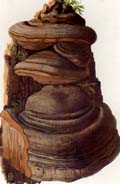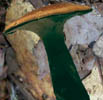Polyporus varius
Older Names
Polyporus elegans
 Key to Gilled Mushrooms Key
Key to Gilled Mushrooms KeyThis is a key to gilled mushrooms, that is, mushrooms having a definite cap with a fertile surface consisting of gills. The fruiting body usually also has a stem, although that may be lateral or absent (usually, then, the mushroom is growing from wood). You can use this key to identify mushrooms that you find.
 Polyporaceae Family
Polyporaceae FamilyFertile surface usually a layer of vertical tubes, of which the mouths are visible as pores on the underside of the cap or shelf.
Fruiting bodies usually tougher or harder than the "normal" gilled mushrooms, being leathery, corky, or woody. But they can be quite tender while actively growing
Once grown, they do not decay easily, remaining on the substrate for months or years
They often grow on wood, although a few are terrestrial (even those are usually growing on buried wood)
Fruiting body is usually a flat shelf, or hoof-shaped, protruding directly from the substrate, although sometimes it may have a short stalk.
Some forms never grow away from the substrate at all, so that all that is visible of the fruiting body are the pores.
Sometimes the pores are so minute that the fertile surface seems solid, until you look closely
 Lignicopolypore Subfamily
Lignicopolypore SubfamilyGrowing on wood
 Stipitoporus Tribe
Stipitoporus TribeNot fitting the other choices, fruiting body with well-developed stem
 Polyporus Genus
Polyporus GenusCap lacking hard crusty upper surface or large, angular pores
Fruiting body flexible if it's not really thick
Polyporus varius Fries
Here are the characters that distinguish this species from the others in its group. For its more general characters, see higher up on the page.
If there's just a few words or a microscopic feature here, a more thorough description can be found above.
Diagnosis
- Cap pale tan to reddish tan, never shiny, soon weathering to a dull white; margin often wavy or lobed
-
Pores white at first, aging grey or brown
-
Up to 4" across; usually only about two
-
Often on dead twigs and small sticks
Comments
A separate species, Polyporus elegans, used to be recognized. At that time, the name Polyporus elegans was the name for the typical form of this species: small, with an off-white cap. Polyporus varius was reserved for the larger (more than 2" across), browner specimens one sometimes encounters, the ones that are easily confused with Polyporus badius, and especially those with streaks of the brown colors in their cap
This was still an issue ten years ago. Now, however, Polyporus elegans is completely subsumed by the correct name. I wonder how the synonymy was done (mating tests? DNA?), and hope to have a report for you. I also wonder why Polyporus varius is the name that "won", as it is Friesian; Polyporus elegans dates from Bulliard, and thus is older






 Key to Gilled Mushrooms Key
Key to Gilled Mushrooms Key Polyporaceae Family
Polyporaceae Family Stipitoporus Tribe
Stipitoporus Tribe Polyporus Genus
Polyporus Genus




